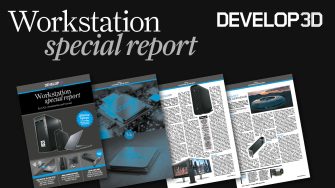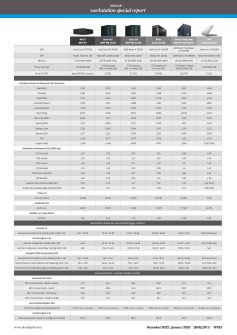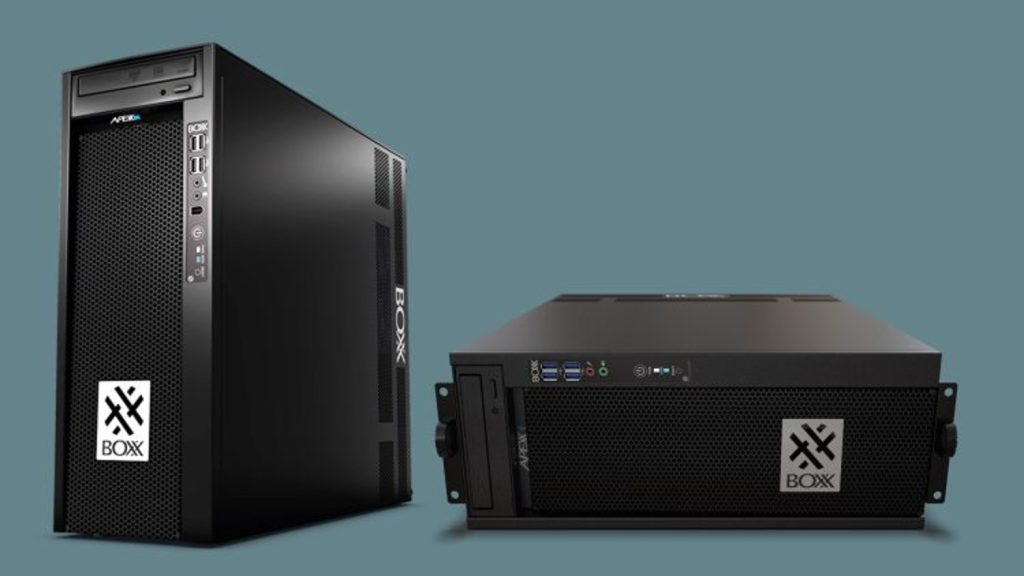Boxx Apexx – This powerful desktop workstation not only offers impressive performance for CAD, thanks to its enhanced Intel Core i9-13900K CPU, but it can be rackmounted for an easy-to-deploy resource for flexible working, writes Greg Corke
Boxx has a long history of building high-performance custom workstations. The Texas-based company not only matches components to specific 3D workflows, but designs and manufactures its own chassis in ‘aircraft-grade’ aluminium. These are solid machines with a strength and rigidity beyond that of most off-the-shelf cases used by other custom manufacturers.
The Boxx Apexx S4.04 also stands out because it is a desktop workstation that can be rack mounted. While the ability to rack mount is not uncommon in workstations from major players like HP and Lenovo, it’s not something we often see done by custom manufacturers.
Boxx has been doing this for years, but it has never been more relevant. With increased demand for flexible working, it makes it easier for firms to support staff working from office or home. Simply set up the workstations in a centralised rack and remote into the machines from anywhere.

Of course, this can be done with dedicated rack workstations / servers, but rack-mounting desktop workstations has two major benefits: first you get the absolute best performance and second you don’t necessarily need a dedicated airconditioned datacenter or server room.
With the Apexx S4, the rack mount kit is included with the machine – you simply bolt it on to the chassis. It is designed to fit a 19” rack with 3/8” square holes.
Form certainly follows function here. The chassis is very angular, essentially a 4U box. There are no bevelled edges, a trademark of the Apexx S3, which offers the same core specs in a smaller chassis with less expandability. One gripe is there are no USB Type C ports on the front, and only two US B Type A (one of which is USB 2.0). But there’s plenty at the rear — two USB Type C and eight USB Type A.
Our test machine was maxed out in CPU and memory, with the top-end Intel Core i9-13900K processor supported by 128 GB of DDR5- 4800 MHz memory.
Boxx has ‘performance enhanced’ the CPU beyond its standard settings, which gives it an edge. It hit 5.97 GHz in single threaded workflows and 4.89 GHz on all cores, which it managed to maintain when rendering in KeyShot for over an hour. This translates to real performance benefits in core workflows. Compared to the other Core i9-13900K workstation we’ve reviewed, the Scan 3XS GWP-ME A132C, it was around 3-4% faster in single or lightly threaded tests in Autodesk Revit, and around 6% faster in the single threaded and multi-threaded Cinebench R23 benchmark. It was marginally slower in V-ray and KeyShot, but these benchmarks take less than a minute to run and, as we found previously, all core frequencies on the Scan machine drop after a couple of minutes.
But Boxx doesn’t have the lead everywhere. Its choice of slower DDR5 4,800 MHz memory looks to have a significant impact on performance in some workflows. The Apexx S4 took 32% longer than the Scan workstation (DDR5 5,600 memory) to recompile shaders in Unreal Engine and 25% longer to process point clouds in Leica Cyclone 360. Both processes also use the GPU a little, so to check the GPU was not the major contributor to the drop in performance we swapped out the Nvidia RTX A4000 for the same GPU, but that only made a very small difference.
Smooth operator

One might presume that running all CPU cores at higher frequencies would have a negative impact on power draw and acoustics. However, this was not the case. Compared to the Scan machine, power draw with all cores was only slightly higher (458W vs 452W) and the Apexx S4 was also quieter. This is testament to Boxx’s CPU tuning and chosen cooling system, which comprises an Asetek 240mm 670LT closed loop liquid cooler and three 120mm fans at the front of the machine. While CPU performance is top notch, Boxx has been more restrained with graphics. However, the Nvidia RTX A4000 is still an excellent GPU for CAD and mainstream visualisation, and with 16 GB of GDDR6 memory it should cover many bases from real-time 3D to GPU rendering.
Indeed, at 4K resolution it delivers a perfectly adequate 25.89 Frames Per Second (FPS) with the Unreal Engine Audi Car Configurator model, and 32.15 FPS in VRED Professional with our automotive scene.
But the single slot card doesn’t reach the same heights as Nvidia’s dual slot RTX cards. And, if you really want to boost you GPU horsepower, then the Apexx 4 and its 1300W power supply, can handle up to dual Nvidia RTX A6000 GPUs, giving you a whopping 96 GB of GPU memory in supported applications.
For storage, there’s the classic combination of 1 TB NVMe SSD and 2 TB 7,200rpm Hard Disk Drive (HDD). Unlike most custom workstation manufacturers, which go with the Samsung 980 Pro, Boxx has chosen the Seagate 530 Firecuda. According to the company, this is down to the longevity of the SSD, with Seagate claiming an endurance of 1,275 Total Bytes Written (TBW), more than double that of the Samsung 980 Pro. Rounding out the specifications there’s 2.5G LAN, 802.11ax Wi-Fi 6E + Bluetooth.
The verdict
If you’re looking for an incredibly powerful, well-built rack mountable workstation for CAD and mainstream visualisation you’ll be hard pushed to find one better than this. However, there’s no escaping the fact that you’ll pay a premium for the pleasure.
There are ways to shed some pounds off the sizeable £5,400 (Ex VAT) price tag. Going down to 64 GB of DDR5 memory will save you £200 and not negatively impact performance, unless you work with very large datasets.
A downgrade to the Nvidia RTX A2000 (12 GB) will also save you £400 and while you’ll take a performance hit in design viz tools like Enscape, V-Ray and KeyShot, you should hardly notice any difference in Revit, Inventor, and Solidworks.
Finally, there’s the Boxx Apexx S3 to consider. If you don’t need to rack mount or expand into multiple HDDs or super high-end dual CPUs, then this more compact sibling should give you the exact same performance without making such a big dent in your precious workstation budget.
Product Specs
Boxx Apexx S4
■ Intel Core i9-13900K processor (3.0 GHz, 5.8 GHz turbo) (8 P-cores, 16 E-cores, 32 threads)
■ Nvidia RTX A4000 GPU (16 GB GDDR6)
■ 128 GB (4 x 32 GB) DDR5-4800 MHz memory
■ 1 TB Seagate 530 Firecuda SSD + 2 TB 7,200rpm Hard Disk Drive (HDD)
■ ASRock Z790 Taichi motherboard
■ Asetek 240mm 670LT closed loop liquid cooler
■ 1300W Seasonic Prime GX-1300 PSU
■ Custom chassis (174 x 457 x 513mm) + rack mount kit
■ Microsoft Windows 11 Pro 64-bit
■ 3 year return to base warranty
■ £5,400 (Ex VAT)
■ boxx-tech.co.uk
This article is part of DEVELOP3D’s Workstation Special Report
Scroll down to read and subscribe here.
Featuring
- Review: 13th Gen Intel Core vs AMD Ryzen 7000 CPUs
- Exclusive Review: Intel Arc Pro A40/A50 GPUs
- Comment: Workstation energy efficiency
- Review: Scan desktop workstations
- Review: HP Z2 Mini G9 workstation
- Review: Armari Magnetar M64TP-RW1300G3
- Review: Dell Precision 5470 mobile workstation
- Round-up: Ultra-portable mobile workstations
- Review: Nvidia RTX A2000 / Nvidia T1000 GPUs
- Review: AMD Radeon Pro OpenGL driver






